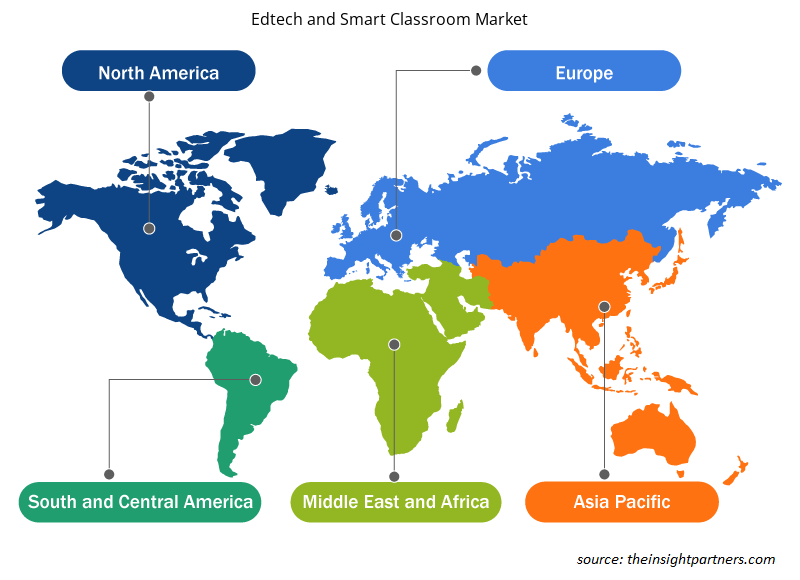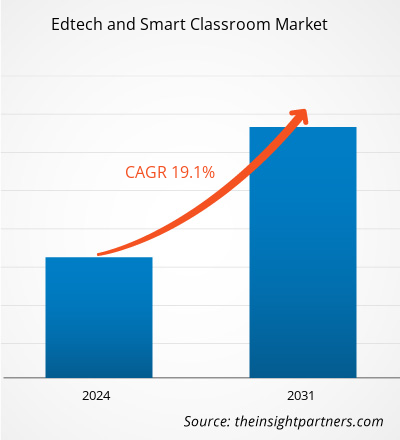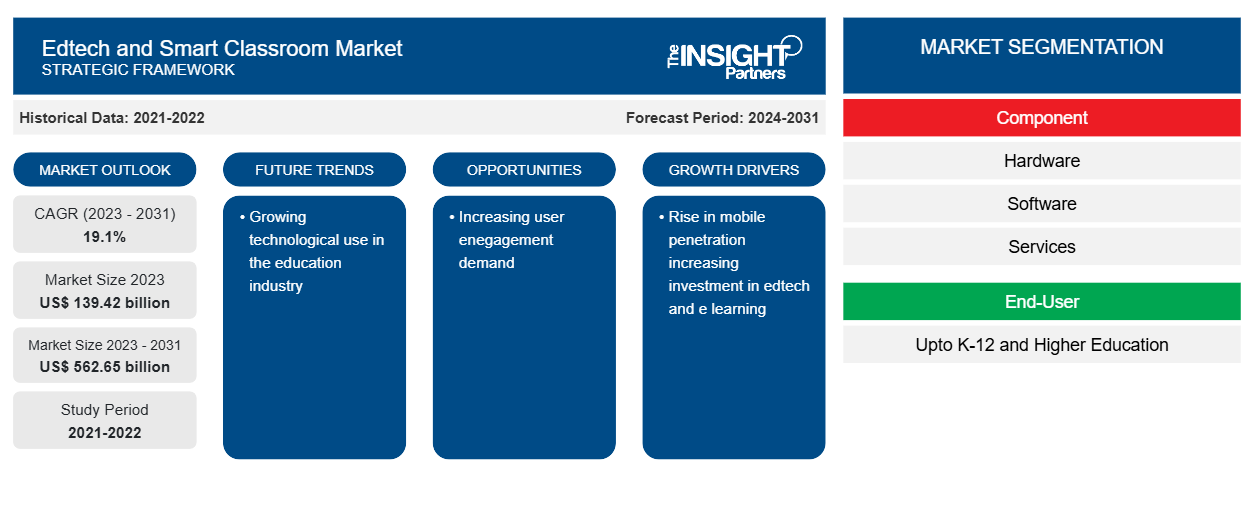에드테크 및 스마트 교실 시장 규모는 2023년 1,394억 2,000만 달러에서 2031년 5,626억 5,000만 달러로 성장할 것으로 예상되며, 2023년에서 2031년 사이에 연평균 성장률 19.1%로 성장할 것으로 추산됩니다. 교육 산업에서 기술 사용이 증가하는 것은 에드테크 및 스마트 교실 시장의 핵심 트렌드로 남을 가능성이 높습니다.
Edtech 및 스마트 교실 시장 분석
IT 시스템, 특히 클라우드 기반 플랫폼은 디지털 수업 계획과 원격 학습에 대한 강조가 커지면서 그 어느 때보다 더 중요합니다. 잠재적으로 클라우드는 사용자의 변화를 촉진하는 기술 혁신입니다. 원격 서버, 네트워킹, 데이터베이스 시스템, 분석, 스토리지 시스템, 소프트웨어 및 기타 디지털 리소스를 사용하여 클라우드 컴퓨팅은 인터넷을 통해 컴퓨팅 서비스를 제공하는 정보 기술 패러다임입니다. 고등 교육의 경우 클라우드 컴퓨팅은 특히 K-12 대학생에게 상당한 이점을 제공합니다. 교육자는 교실에서 클라우드 컴퓨팅을 활용하여 가상 수업을 쉽게 진행하고 다양한 온라인 과제와 프로그램에 학생들을 포함시킬 수 있습니다. 따라서 가상 수업의 사용이 증가함에 따라 에드테크 및 스마트 교실 시장 의 성장이 촉진되고 있습니다.
Edtech 및 스마트 교실 시장 개요
클라우드는 적응형 저장 및 사용 방법, 강력한 보안 기능, 사용의 간편성으로 인해 가장 광범위하게 사용되는 기술입니다. 교육자는 저렴한 온라인 학습, 파일 공유, 다양한 형식의 방대한 파일 저장을 위해 클라우드를 활용할 수 있습니다. 이 때문에 거의 모든 EdTech 기업과 교육 기관은 클라우드 사용을 선호합니다. 게임화를 통한 학습은 또 다른 창의적인 유행입니다. 교육 기술 과 관련하여 기존의 교육 방법은 힘들고 집중적인 게임화가 필요하지만 학습을 즐거운 노력으로 바꿔줍니다. 게임화를 통해 학생들은 타이머 또는 서로 경쟁하고 리더보드에서 실시간으로 진행 상황을 보고 높은 점수에 대한 상을 받을 수 있습니다. 오늘날의 사용자에게 이는 학습의 흥분과 즐거움을 증가시켰습니다. 많은 주요 회사가 이 에드테크 및 스마트 교실 트렌드에 대응하여 마케팅 트렌드로 게임화를 사용했습니다.
귀하의 요구 사항에 맞게 이 보고서를 사용자 정의하세요
이 보고서의 일부 또는 국가 수준 분석, Excel 데이터 팩을 포함하여 모든 보고서에 대한 사용자 정의를 무료로 받을 수 있으며 신생 기업 및 대학을 위한 훌륭한 혜택과 할인 혜택을 이용할 수 있습니다.
-
이 보고서의 주요 시장 동향을 알아보세요.이 무료 샘플에는 시장 동향부터 추정 및 예측까지 다양한 데이터 분석이 포함됩니다.
Edtech 및 스마트 교실 시장 동인 및 기회 and Smart Classroom Market Drivers and Opportunities
모바일 보급률 증가로 시장 성장에 유리
모바일 보급률은 저소득층에서 가장 높습니다. Saperstein에 따르면 AT&T는 저소득층과 농촌 지역의 50,000명의 학생들에게 모바일 연결과 가젯을 제공하기 위해 1억 달러를 제공했습니다. 세계에서 두 번째로 인구가 많은 나라인 인도는 180억 명의 인구를 가지고 있으며(세계은행) 2024년까지 중국을 제치고 가장 인구가 많은 나라가 될 수 있습니다(UN 보고서).Saperstein. India, the world's second most populous country, with 18 billion people (World Bank), may overtake China to become the most populated country by 2024 (UN Report).
또한 인도는 가장 젊은 인구 중 하나이며, 인도 인구의 약 30%가 18~34세이고 2억 6천만 명의 학생이 있습니다. Project Tomorrow 보고서에 따르면 2022년 현재 미국 고등학생의 33%와 중·초등학생의 31%가 학교에서 지급한 모바일 기기를 가지고 있습니다. 모바일 기기의 광범위한 사용으로 인해 게임화 , 가상 교실, e러닝이 증가하고 있으며, 이는 에드테크 및 스마트 교실 시장의 성장을 촉진하고 있습니다.edtech and smart classroom market.
Edtech 및 스마트 교실 시장 보고서 세분화 분석
Edtech 및 스마트 교실 시장 분석 도출에 기여한 주요 세그먼트는 구성 요소와 최종 사용자입니다.
- 에드테크 및 스마트 교실 시장은 구성요소를 기준으로 하드웨어, 소프트웨어, 서비스로 구분됩니다.
- 최종 사용자를 기준으로 볼 때, 에드테크 및 스마트 교실 시장은 K-12 및 고등 교육으로 세분화됩니다.
지역별 Edtech 및 스마트 교실 시장 점유율 분석
- 에드테크 및 스마트 교실 시장은 북미, 유럽, 아시아 태평양(APAC), 중동 및 아프리카(MEA), 남미 및 중미의 5개 주요 지역으로 세분화됩니다. 아시아 태평양 지역은 예측 기간 동안 가장 높은 CAGR로 성장할 것으로 예상됩니다.
- 중국은 지난 몇 년 동안 ICT 인프라와 교육 리소스에 상당한 투자를 했으며, 이를 통해 교육 분야에서 기술 통합이 진전되었습니다. 중국에서는 최근 몇 년 동안 온라인 학습이 인기를 얻었습니다. e러닝 사용자가 점점 더 보편화되고 있습니다. 예를 들어, 이 지역은 온라인 학습, VIPKid, 4~15세 중국 어린이에게 일대일 영어 수업을 제공하는 교육 플랫폼을 포함한 여러 e러닝 시스템을 제공합니다. 중국인. e러닝이 처음 등장한 1990년대 이후 정부는 많은 정책을 실행하면서 개발에 많은 중점을 두었습니다. 그 결과 이 지역은 e러닝 분야에서 많은 성과를 거두었으며, 이는 에드테크와 스마트 교실 시장의 성장을 촉진하고 있습니다.
Edtech 및 스마트 교실 시장 지역 통찰력
Insight Partners의 분석가들은 예측 기간 동안 Edtech 및 스마트 교실 시장에 영향을 미치는 지역적 추세와 요인을 철저히 설명했습니다. 이 섹션에서는 북미, 유럽, 아시아 태평양, 중동 및 아프리카, 남미 및 중미의 Edtech 및 스마트 교실 시장 세그먼트와 지리에 대해서도 설명합니다.

- Edtech 및 스마트 교실 시장을 위한 지역별 데이터 얻기
Edtech 및 스마트 교실 시장 보고서 범위
| 보고서 속성 | 세부 |
|---|---|
| 2023년 시장 규모 | 1,394억 2,000만 달러 |
| 2031년까지 시장 규모 | 5626억 5천만 달러 |
| 글로벌 CAGR (2023-2031) | 19.1% |
| 역사적 데이터 | 2021-2022 |
| 예측 기간 | 2024-2031 |
| 다루는 세그먼트 |
구성 요소별로
|
| 포함된 지역 및 국가 |
북아메리카
|
| 시장 선도 기업 및 주요 회사 프로필 |
|
시장 참여자 밀도: 비즈니스 역학에 미치는 영향 이해
Edtech 및 스마트 교실 시장 시장은 소비자 선호도의 변화, 기술 발전, 제품의 이점에 대한 인식 증가와 같은 요인으로 인해 최종 사용자 수요가 증가함에 따라 빠르게 성장하고 있습니다. 수요가 증가함에 따라 기업은 제품을 확장하고, 소비자의 요구를 충족하기 위해 혁신하고, 새로운 트렌드를 활용하여 시장 성장을 더욱 촉진하고 있습니다.
시장 참여자 밀도는 특정 시장이나 산업 내에서 운영되는 회사나 기업의 분포를 말합니다. 주어진 시장 공간에 얼마나 많은 경쟁자(시장 참여자)가 존재하는지 그 규모나 총 시장 가치에 비해 나타냅니다.
Edtech 및 스마트 교실 시장에서 운영되는 주요 회사는 다음과 같습니다.
- 애플 주식회사
- 블랙보드 주식회사
- 시스코 시스템즈 주식회사
- 디투엘 주식회사
- IBM 주식회사
- 레노버 그룹 리미티드
면책 조항 : 위에 나열된 회사는 어떤 특별한 순서에 따라 순위가 매겨지지 않았습니다.

- Edtech 및 스마트 교실 시장의 주요 주요 업체 개요를 알아보세요
Edtech 및 스마트 교실 시장 뉴스 및 최근 개발
피어 투 피어 보험 시장은 1차 및 2차 연구 이후의 질적, 양적 데이터를 수집하여 평가합니다. 여기에는 중요한 기업 출판물, 협회 데이터 및 데이터베이스가 포함됩니다. 다음은 에드테크 및 스마트 교실 시장의 개발 목록입니다.
- 2022년 7월, Blackboard Inc.는 Blackboard SaaS EdTech 생태계 내에서 학습 도구 사용에 대한 인식을 제공하는 보고서를 기관에 제공하는 Blackboard Data 플랫폼용 보고 계층 출시를 발표했습니다.
(출처: Blackboard Inc, 보도자료)
- 2022년 9월, Cisco는 물리적 위치에 관계없이 교사, 학생, 학부모를 단일 공간에서 안전하게 연결하는 Webex Classrooms를 출시했습니다.
(출처: 시스코, 보도자료)
Edtech 및 스마트 교실 시장 보고서 범위 및 제공물
"Edtech 및 스마트 교실 시장 규모 및 예측(2021-2031)"은 아래에 언급된 영역을 포괄하는 시장에 대한 자세한 분석을 제공합니다.
- 범위에 포함된 모든 주요 시장 세그먼트에 대한 글로벌, 지역 및 국가 수준의 시장 규모 및 예측
- 동인, 제약 및 주요 기회와 같은 시장 역학
- 주요 미래 트렌드
- 자세한 PEST/포터의 5가지 힘과 SWOT 분석
- 주요 시장 동향, 주요 업체, 규정 및 최근 시장 동향을 포괄하는 글로벌 및 지역 시장 분석
- 시장 집중도, 히트맵 분석, 유명 기업 및 최근 개발 사항을 포함하는 산업 환경 및 경쟁 분석
- 자세한 회사 프로필
- 과거 분석(2년), 기준 연도, CAGR을 포함한 예측(7년)
- PEST 및 SWOT 분석
- 시장 규모 가치/거래량 - 글로벌, 지역, 국가
- 산업 및 경쟁 환경
- Excel 데이터세트
최근 보고서
사용 후기
구매 이유
- 정보에 기반한 의사 결정
- 시장 역학 이해
- 경쟁 분석
- 고객 인사이트
- 시장 예측
- 위험 완화
- 전략 기획
- 투자 타당성 분석
- 신흥 시장 파악
- 마케팅 전략 강화
- 운영 효율성 향상
- 규제 동향에 발맞춰 대응























 무료 샘플 받기 - 에드테크와 스마트 교실 시장
무료 샘플 받기 - 에드테크와 스마트 교실 시장